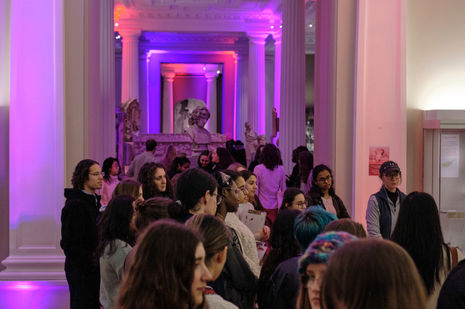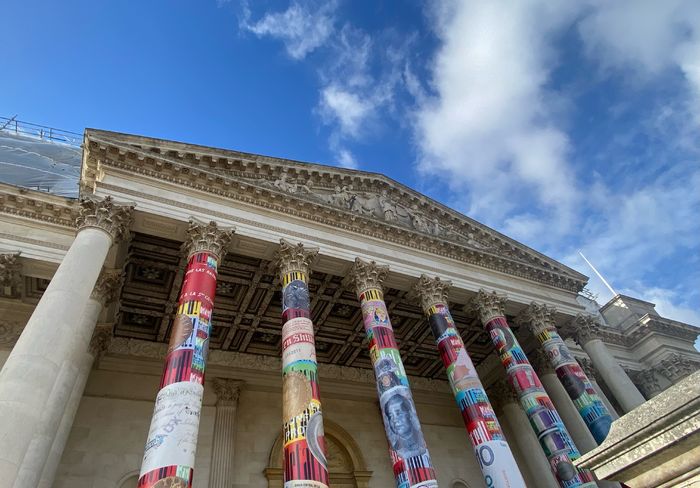‘A gathering, a festival, a promenade’: Love Art After Dark at the Fitzwilliam Museum
A jam-packed evening of culture at the Fitzwilliam’s Love Art After Dark leaves Arts writer Anna Wythe wondering whether sometimes less is more

I am trekking through a forest of marble trying to balance a porcelain shepherdess on my nose. I am trying to lick every shop window without seeing my own reflection. A one-night-rendezvous with Love Art After Dark left me spiralling in the strange kind of psychic challenges we inflict on ourselves in dreams.
Perhaps the problem was one of definition. It was a gathering, a festival, a promenade, and yet none of these. It was, quintessentially, an event. When I looked for the heart of Love Art After Dark, I found myself continually referred back to the spectacle, the lights, the setting. A fellow attendee told me their favourite part of the event was simply “the atmosphere”.
“It is no great tragedy to be overwhelmed by wonderful things”
Perhaps I was trying to understand something that I could simply have basked in, but bask I did not. “Distracted from distraction by distraction.” Like those who flick through newspapers absent-mindedly in Tom Eliot’s “Burnt Norton”, I found myself “with no concentration”, but unlike them, I was also disoriented, sweaty and anxious.
On one level, this was a matter of logistics: the quickfire schedule, the crowds, the overlapping spaces where events took place. With one ear I listened to a talk about ancient civilisation while the other filled with snatches of slam poetry. I could listen to neither properly. In fact, I could barely stop to look at an armless Aphrodite without being elbowed out of the way by a mullet and a crochet waistcoat.
So too, there was the rapidity of the event: at a curt two hours, there was little leisure and none of that museum-y sense of detachment from the pace of daily life. A poet looked up in confusion as the overhead announcement to exit the venue interrupted her reading. The audience shrugged uncomfortably, then scurried back to still-wet umbrellas.
I don’t think I can lay my sense of dislocation at the feet of the organisers. Though I have no previous experience of the event, my instinct is that they delivered Love Art After Dark as it is meant to be: a confection of cultural appetisers at the Fitzwilliam Museum. The event featured a zine fair, two poetry recitals, life drawing, talks and tours of the museum, not to mention several beautiful musical performances. It is no great tragedy to be overwhelmed by wonderful things. Still, to my mind, the gathering of these elements of Cambridge’s cultural scene was to the detriment not the enhancement of each.
It felt oddly like I had entered the digital realm. Everything was at my fingertips, yet the simultaneous availability of so much left me frazzled and apathetic. I thought of George Sorel’s essay “The Metropolis and Mental Life”, where he writes about the “blasé attitude” that originates “from the rapidly changing and closely compressed contrasting stimulations of the nerves … A life in boundless pursuit of pleasure makes one blasé because it agitates the nerves to their strongest reactivity for such a long time that they finally cease to react at all.”
“There were moments when the meandering, overlapping nature of the event really worked”
Where Sorel diagnosed the metropolis of the early twentieth century, our habitat is being in constant proximity to the virtual. What the hyperstimulation of Love Art After Dark created was a live instantiation of the virtual experience. I scrolled through it. I bathed my eyeballs in purple light. I bit at images and spat them out because chewing felt too much like work.
Of course, I’m exaggerating a little. There were moments when the meandering, overlapping nature of the event really worked. A haunting opera aria drew us through a maze of marble statues like a siren luring sailors. The naked bodies that appeared in student artwork gained a striking vulnerability from the display of weapons they were surrounded by. The torsos seemed tense with the knowledge that a dozen daggers pointed threateningly at them. In these moments, the museum exhibits intertwined with the event installations in a way that amplified them both.
Yet too often it felt as though culture had been stacked haphazardly on culture until it was all just a bunch of stuff. The Fitzwilliam functioned awkwardly as both backdrop and exhibit. The vast quantity of cultural artefacts almost seemed a burden. What linked our little bits of paper and poetry to the hulking marbles, or even to the hideous porcelain shepherdesses? I couldn’t find either in the theme of mythology or in the idea of “love art” something that could bring coherence to all these different elements.
I am not quite crazy enough to expect a unified theory of culture from a two-hour event. Rather, I wanted the lack of one, the chaos of jamming everything in together, to be acknowledged. Baudelaire reminds us that “modernity is the fleeting, the ephemeral, the contingent,” and the many aspects of Love Art After Dark threw each other into a painful contingency. A clearer purpose might have allowed those conflicts to coexist productively, rather than just messily. After all, purple lights can’t fix everything.
 Comment / Cambridge is right to scrap its state school target1 May 2024
Comment / Cambridge is right to scrap its state school target1 May 2024 News / Academics call for Cambridge to drop investigation into ‘race realist’ fellow2 May 2024
News / Academics call for Cambridge to drop investigation into ‘race realist’ fellow2 May 2024 News / Gender attainment gap to be excluded from Cambridge access report3 May 2024
News / Gender attainment gap to be excluded from Cambridge access report3 May 2024 News / Cambridge postgrad re-elected as City councillor4 May 2024
News / Cambridge postgrad re-elected as City councillor4 May 2024 Comment / Accepting black people into Cambridge is not an act of discrimination3 May 2024
Comment / Accepting black people into Cambridge is not an act of discrimination3 May 2024





